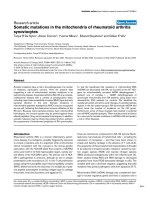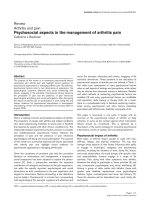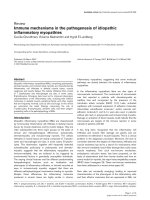Báo cáo y học: "Gastrointestinal dysfunction in the critically ill: can we measure it" doc
Bạn đang xem bản rút gọn của tài liệu. Xem và tải ngay bản đầy đủ của tài liệu tại đây (39.8 KB, 2 trang )
Page 1 of 2
(page number not for citation purposes)
Available online />Abstract
Gastrointestinal dysfunction is an intuitively important, yet
descriptively elusive component of the multiple organ dysfunction
syndrome. Reintam and colleagues have attempted to quantify this
dimension using a combination of intolerance of enteral feeding,
and the development of intra-abdominal hypertension. While they
show that both parameters are associated with an increased risk of
death (and therefore that, in combination, the risk of death is even
greater), they fall short in developing a novel descriptor of gastro-
intestinal dysfunction. Nonetheless, and even with its short-
comings, their effort is a welcome contribution to the surprisingly
complex process of describing the morbidity of critical illness.
In the previous issue of Critical Care, Reintam and colleagues
[1] report a novel scale for measuring gastrointestinal dys-
function, using as descriptors, feeding intolerance and intra-
abdominal hypertension. They demonstrate convincingly that
their Gastrointestinal Failure Score correlates in a graded
manner with mortality, and adds prognostic power to the
Sepsis-related Organ Failure Assessment (SOFA) score. But
while the use of intra-abdominal hypertension as a measure of
gastrointestinal dysfunction is novel, and reflects morbidity
that was underappreciated 10 years ago, their scale falls
short in providing a comprehensive measure of gastro-
intestinal dysfunction in critical illness.
The concept that the morbidity of critical illness arises
through the development of potentially reversible physiologic
failure of multiple organ systems was first articulated by
Arthur Baue more than 30 years ago [2]. It was further refined
by the ACCP/SCCM consensus conference of 1991, which
suggested that the process involved graded degrees of
organ system dysfunction, and proposed the terminology
‘multiple organ dysfunction syndrome’ (MODS) to describe it
[3]. The concept embodies several key features. First, it
recognizes that it is not a single event that jeopardizes the
recovery of the critically ill patient, but rather an evolving state
of physiologic insufficiency, often affecting organs remote to
the site of the initial insult and necessitating the use of
exogenous support to ensure survival. Second, it reflects the
clinical reality that the process is variable in its expression,
with differing systems being involved in different patients.
Finally, and of most pragmatic importance, the process is
potentially reversible, and survival is possible, though strongly
and inversely correlated with the aggregate severity of the
process.
Some 15 to 20 years ago, there emerged a spate of efforts to
provide robust and reproducible criteria for the objective
measurement of organ dysfunction [4-7]. These are strikingly
similar in their architecture, a reflection not only of an
emerging consensus on what organ dysfunction is, but also
of the substantial intellectual collaboration of those who
developed the scores. Although the final products vary in
specific details, they reflect an implicit consensus that a valid
descriptor of organ dysfunction should meet certain criteria
(Table 1).
The rationale for quantifying organ dysfunction is not to
provide another tool to predict the outcome of critically ill
patients; dedicated prognostic scores such as the Simplified
Acute Physiology Score (SAPS) and Acute Physiology and
Chronic Health Evaluation (APACHE) do this more than
adequately. Rather, their purpose is to measure the evolution
over time of a multi-dimensional process, to enable response
to specific unmet needs. First, an organ dysfunction scale
can serve as a measure of intensive care unit-related
morbidity, and so reflect important, but non-mortal, outcomes
in a complex patient population. Second, it can provide an
aggregate measure of whether an individual patient is
improving or deteriorating over time - a common challenge in
an illness characterized by improvement in some dimensions,
and deterioration in others. Third, it can measure new
Commentary
Gastrointestinal dysfunction in the critically ill: can we measure it?
Rachel G Khadaroo and John C Marshall
Departments of Surgery and Critical Care Medicine, and the Li Ka Shing Knowledge Institute, St. Michael’s Hospital, University of Toronto, Toronto,
Ontario, Canada, M5B 1W8
Corresponding author: John C Marshall,
Published: 24 September 2008 Critical Care 2008, 12:180 (doi:10.1186/cc7001)
This article is online at />© 2008 BioMed Central Ltd
See related research by Reintam et al., />MODS = multiple organ dysfunction syndrome.
Page 2 of 2
(page number not for citation purposes)
Critical Care Vol 12 No 5 Khadaroo and Marshall
morbidity arising in a patient whose risk of dying at the time of
intensive care unit admission is quantifiable, but unalterable,
and for whom the real goal of care is to prevent de novo
morbidity. Finally, it can serve as a more sensitive and
informative outcome measure for a population of patients for
whom mortality risk is heavily influenced by pre-morbid
conditions, and survival per se is of variable importance.
Gastrointestinal failure was a classic feature in early
descriptions of MODS, and invariably measured as bleeding
from acute stress ulceration of the stomach [8,9]. But stress
ulceration has become distinctly uncommon [10], and so
other metrics have been sought, including tolerance of
enteral feeds, ileus and nasogastric drainage, intestinal
ischemia, acalculous cholecystitis, and diarrhea [11]. None of
these have satisfactorily met criteria for face validity and utility
as summarized in Table 1, and for this reason, gut dysfunction
was omitted from the available organ dysfunction scales.
The work of Reintam and colleagues has several limitations.
First, tolerance of enteral feeding is subjective, and reflects a
clinical decision - to withhold feeds - more than it does an
intrinsic characteristic of the patient. One would want to
know how reproducible these criteria were when measured
by different observers, and whether they showed a graded
correlation with mortality risk; the simple measure of
nasogastric output does not.
Second, intra-abdominal hypertension is not strictly a measure
of gastrointestinal dysfunction, but rather of the combination
of increased intra-abdominal pressure and decreased
compliance of the abdominal wall, and its risk factors are
conditions characterized by a need to administer large
amounts of fluid in the setting of significantly increased
capillary permeability [12].
These shortcomings notwithstanding, however, the authors
are to be complimented on their continuing efforts to improve
our ability to describe a common, frustratingly elusive, but
intuitively important element of the MODS. In an earlier
publication, they found that the development of gastro-
intestinal failure reflected in a diverse group of gastrointes-
tinal signs and symptoms was associated with an eightfold
increase in mortality [13]; clearly, this is a problem that we
need to understand better.
Competing interests
The authors declare that they have no competing interests.
References
1. Reintam A, Parm P, Kitus R, Starkopf J, Kern H: Gastrointestinal
Failure score in critically ill patients: a prospective observa-
tional study. Crit Care 2008, 12:R90.
2. Baue AE: Multiple, progressive, or sequential systems failure.
A syndrome of the 1970s. Arch Surg 1975, 110:779-781.
3. Bone RC, Balk RA, Cerra FB, Dellinger RP, Fein AM, Knaus WA,
Schein RM, Sibbald WJ: Definitions for sepsis and organ
failure and guidelines for the use of innovative therapies in
sepsis. Chest 1992, 101:1644-1655.
4. Marshall JC, Cook DJ, Christou NV, Bernard GR, Sprung CL,
Sibbald WJ: Multiple organ dysfunction score: A reliable
descriptor of a complex clinical outcome. Crit Care Med 1995,
23:1638-1652.
5. Vincent JL, Moreno R, Takala J, Willatts S, De Mendonça A, Bruin-
ing H, Reinhart CK, Suter PM, Thijs LG: The sepsis-related
organ failure assessment (SOFA) score to describe organ
dysfunction/failure. Intens Care Med 1996, 22:707-710.
6. Bernard G: The Brussels score. Sepsis 1997, 1:43-44.
7. Le Gall JR, Klar J, Lemeshow S, Saulnier F, Alberti C, Artigas A,
Teres D: The logistic organ dysfunction system - a new way to
assess organ dysfunction in the intensive care unit. JAMA
1996, 276:802-810.
8. Skillman JJ, Bushnell LS, Goldman H, Silen W: Respiratory
failure, hypotension, sepsis, and jaundice. A clinical syndrome
associated with lethal hemorrhage and acute stress ulcera-
tion in the stomach. Am J Surg 1969, 117:523-530.
9. Fry DE, Pearlstein L, Fulton RL, Polk HC: Multiple system organ
failure. The role of uncontrolled infection. Arch Surg 1980,
115:136-140.
10. Cook D, Heyland D, Griffith L, Cook R, Marshall J, Pagliarello J:
Risk factors for clinically important upper gastrointestinal
bleeding in patients requiring mechanical ventilation. Crit
Care Med 1999, 27:2812-2817.
11. Marshall JC: Clinical markers of gastrointestinal dysfunction. In
Gut Dysfunction in Critical Illness. Edited by Rombeau JL, Takala
J. Berlin: Springer-Verlag; 1996:114-128.
12. An G, West MA: Abdominal compartment syndrome: a
concise clinical review. Crit Care Med 2008, 36:1304-1310.
13. Reintam A, Parm P, Redlich U, Tooding LM, Starkopf J, Köhler F,
Spies C, Kern H: Gastrointestinal failure in intensive care: a
retrospective clinical study in three different intensive care
units in Germany and Estonia. BMC Gastroenterol 2006, 6:19.
Table 1
Characteristics of an optimal descriptor of organ dysfunction
Specific for the function of the organ system of interest
Comprehensive measure of function in that system
Sensitive to clinically important change in function
Recognizable to clinician
Increasing abnormality associated with increasing risk of adverse outcome
Not readily reversed by resuscitation
Objective
Measure of physiologic derangement, rather than treatment decision
Reliably, readily, and reproducibly measured
Inexpensive
Abnormal in one direction only
Single, continuous variable
Adapted from [4].









